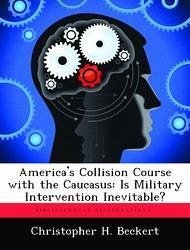Nicht lieferbar

America's Collision Course with the Caucasus: Is Military Intervention Inevitable?
Versandkostenfrei!
Nicht lieferbar
The Caucasus is developing into a vital strategic region. It emerged from the Soviet Union's shadow in 1991 and spawned wild oil and gas speculation, and U.S. policy makers developed relationships with the region's countries as it matured. However, ethnic tensions and separatist movements in the Caucasus still pose a significant threat to American interests. Will the U.S. military intervene to stabilize the Caucasus by 2010? This monograph explores this question. It introduces the reader to the Caucasus' complexity and presents factors affecting a military intervention decision. It presents th...
The Caucasus is developing into a vital strategic region. It emerged from the Soviet Union's shadow in 1991 and spawned wild oil and gas speculation, and U.S. policy makers developed relationships with the region's countries as it matured. However, ethnic tensions and separatist movements in the Caucasus still pose a significant threat to American interests. Will the U.S. military intervene to stabilize the Caucasus by 2010? This monograph explores this question. It introduces the reader to the Caucasus' complexity and presents factors affecting a military intervention decision. It presents three likely contingencies that may require U.S. force intervention before 2010: peacekeeping in the Nagorno-Karabakh region, stabilization of the Georgian or Azerbaijani governments, or prevention of ethnic cleansing. It also provides a summary of each contingency compared to the 1999 National Security Strategy's criteria for deploying U.S. forces to assess the probability of intervention. The monograph is a passport to the Caucasus, removing the mystery from it to assess its operational challenges. The key to success in future military operations there is understanding the Caucasus' diversity and it's emerging international significance. This work has been selected by scholars as being culturally important, and is part of the knowledge base of civilization as we know it. This work was reproduced from the original artifact, and remains as true to the original work as possible. Therefore, you will see the original copyright references, library stamps (as most of these works have been housed in our most important libraries around the world), and other notations in the work. This work is in the public domain in the United States of America, and possibly other nations. Within the United States, you may freely copy and distribute this work, as no entity (individual or corporate) has a copyright on the body of the work. As a reproduction of a historical artifact, this work may contain missing or blurred pages, poor pictures, errant marks, etc. Scholars believe, and we concur, that this work is important enough to be preserved, reproduced, and made generally available to the public. We appreciate your support of the preservation process, and thank you for being an important part of keeping this knowledge alive and relevant.











